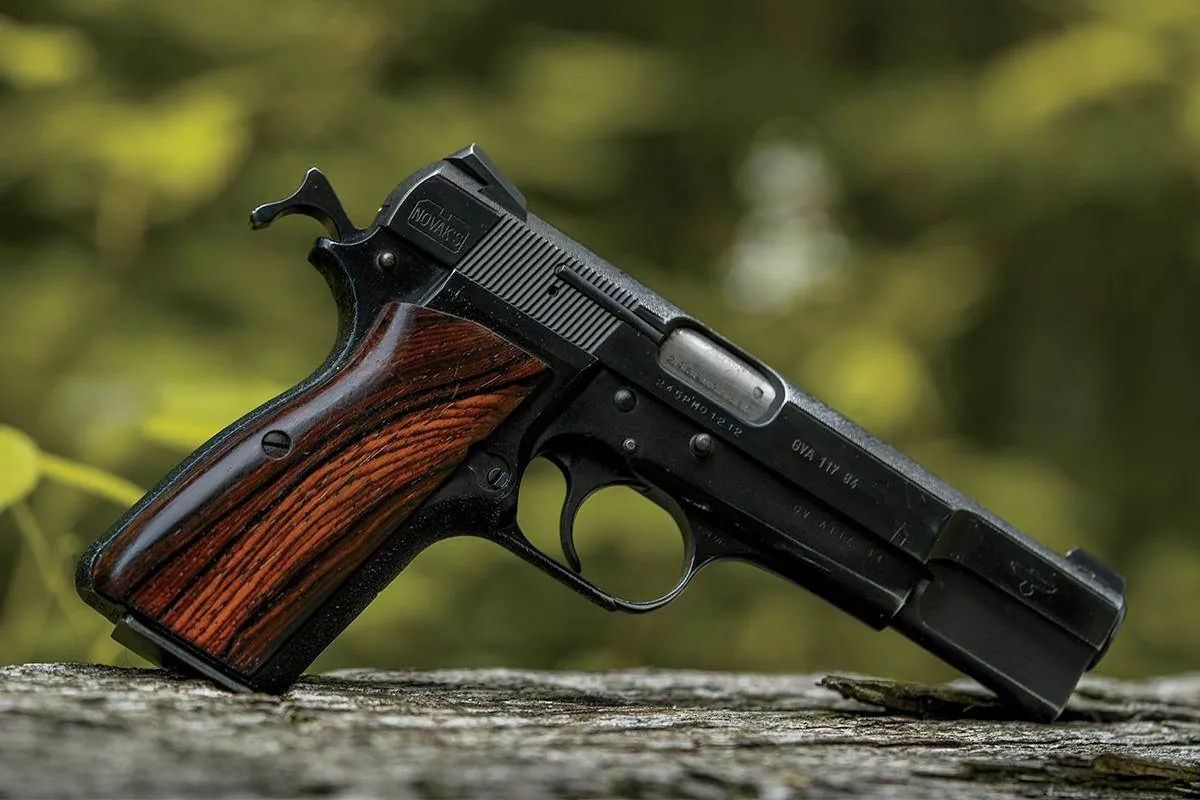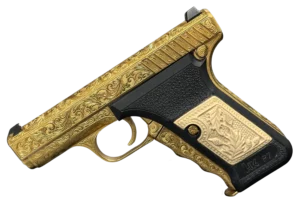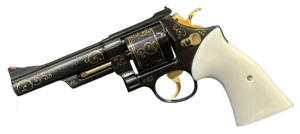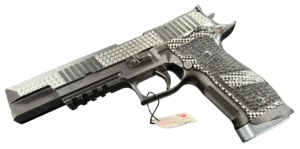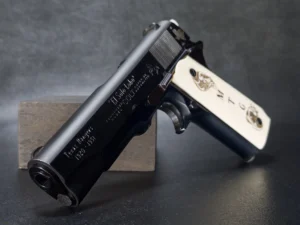Key Takeaways:
- The Browning Hi-Power wasn’t just another pistol — it was the final masterpiece of John Browning, made even more iconic by the designer who finished it after his death: It began as Browning’s last project and evolved into a symbol of global firepower, with Dieudonné Saive stepping in to bring it to life. The result? A pistol that outlived wars, crossed enemy lines, and reshaped handgun design.
- Its double-stack magazine and smooth, balanced design set the tone for modern handguns decades ahead of their time: Back when most pistols were still carrying 7 or 8 rounds, the Hi-Power showed up with 13 and a feel in the hand that just made sense. That kind of design foresight doesn’t come around often—and it’s still influencing gunmakers today.
- Even after production ended in 2017, the Hi-Power refused to disappear—because legends don’t retire quietly: Instead of fading out, it inspired a new wave of clones, modern tributes, and a collector frenzy. From Springfield to FN’s reboot, the Hi-Power lives on—not just as a piece of history, but as a pistol people still genuinely love to shoot.
Some guns are just tools. Others—well, they stick with you. They’ve got stories baked into their steel. The Browning Hi-Power is one of those.
It’s not just a pistol. It’s the final chapter from John Browning himself—the guy who wrote the book on modern firearms. And funny enough, he didn’t even get to finish this one.
What followed was a decades-long journey involving patent drama, war, reinvention, and a global legacy that still echoes in gun design today. So yeah, if you’ve ever wondered what makes the Hi-Power so revered—not just by collectors and historians, but by soldiers, gunsmiths, and action movie directors—buckle up.
This story’s got range.
John Browning’s Final Act
Let’s rewind to the 1920s. John Browning had already changed the world multiple times. Shotguns, pistols, machine guns—if it fired a round and mattered, odds are he had a hand in it.
And then came the Hi-Power. Browning had been working on a new military pistol to meet a French requirement: a modern sidearm with a higher capacity than the standard fare, ideally holding more than eight rounds. That may not sound like much now, but back then? Revolutionary.
Browning got started on the design, but in 1926, he passed away at his workbench. The design was only halfway there.
Luckily, FN Herstal (Belgium’s Fabrique Nationale), where Browning had worked for years, handed the blueprints over to Dieudonné Saive. This name doesn’t get nearly enough credit, considering what he pulled off next.
From Browning to Saive: A Firearm Is Born
Saive picked up where Browning left off, but things weren’t exactly smooth. Since Colt still held the patents on some of Browning’s earlier work, Saive couldn’t just copy the tried-and-true 1911 internals.
So he reimagined the system. He developed a new locked breech, short-recoil mechanism—and perhaps most critically —a double-stack magazine that held 13 rounds of 9mm. That was unheard of at the time.
It wasn’t just a workaround—it was a leap forward.
By 1935, the pistol we now call the Browning Hi-Power (or Grand Puissance in French, hence “Hi-Power”) was born. Sleek. Reliable. Ahead of its time.
And it didn’t take long for the world to notice.
A War-Tested Icon
If you ever wanted proof that a design works, check this out: the Hi-Power was one of the few firearms used by both Axis and Allied forces during World War II.
Yep. The Germans produced them under occupation at the FN factory in Belgium. Meanwhile, the Allies continued to grow them in Canada (hello, Inglis models). Surreal, right? The same pistol was pointed both ways across the battlefield.
After World War II, the Hi-Power didn’t fade—it spread. Fast. From the Middle East to Europe to Southeast Asia, this pistol became standard issue for over 50 armies. That includes Britain’s SAS, Israeli forces, Canadian troops, and many more.
And it wasn’t just about the warzone. Law enforcement adopted it, too. From Northern Ireland’s Royal Ulster Constabulary to police departments in South America, the Hi-Power earned a rep for being simple to use, accurate under pressure, and tough enough to handle… pretty much everything.
It served through:
- World War II
- Korean War
- Vietnam
- Falklands
- Gulf War
- Afghanistan
- Iraq
That’s more mileage than most rifles get, let alone a sidearm.
So What Made It Special?
First off, the magazine. A 13+1 capacity back in the ‘30s? That was groundbreaking. At a time when most sidearms held seven or eight rounds, the Hi-Power doubled that without ballooning in size.
Next: the ergonomics. The Hi-Power… fits. The balance, the natural aim point, the single-action trigger—it’s the kind of gun that feels intuitive the moment you pick it up.
Its mechanics were just as refined. The locked breech, short-recoil setup ensured smooth cycling and reliable performance, even in rough field conditions. The design was also straightforward to disassemble and clean, which was particularly important for soldiers operating in less-than-ideal conditions.
And it looked good, too. That helps.
Variants, Upgrades, and Oddballs
If you’re a collector—or just a gun geek who likes the weird ones—the Hi-Power’s family tree is full of fun branches.
There’s the Mark II, introduced in the 1980s, with improved sights, an ambidextrous safety, and a bit more modern feel. Then came the Mark III: even tougher, with a black epoxy finish and firing pin safety.
There were also compact versions, like the Detective model—harder to find, but very cool. Some Hi-Powers were made in .40 S&W for a hot minute. Not as classic, maybe, but still part of the evolution.
Then there are the Inglis models from Canada (produced during wartime with tangent sights and shoulder stocks), the Israeli surplus models that flooded the U.S. market in the early 2000s, and even some Argentine-licensed copies.
Each has its quirks. Each tells a different story.
The Collector’s Angle
Hi-Powers are everywhere… and yet, not all are created equal.
Early Belgian FN models with the internal extractor? Those get collectors excited. The same applies to wartime production pieces—especially those marked with Nazi insignia (a strange yet fundamental aspect of the collector world).
Condition matters, of course, but so does history if a Hi-Power has provenance—a service history, a letter, a notable user—that adds value.
And prices have been climbing, especially since production ceased. We’ll get to that.
Hollywood Loves a Hi-Power
You’ve probably seen a Hi-Power and didn’t even realize it.
It appears in films like Léon: The Professional, Ronin, The Untouchables, and even some Bond films. It’s got a cinematic look: sleek slide, sculpted grip, and an understated cool.
But it’s not just about looks. The Hi-Power was often the real-deal sidearm used by real-life intelligence units, military advisors, and—yes—occasionally the people chasing or being chased in those movies.
That authenticity gives it on-screen cred. It’s not just a prop—it’s a character.
2017: The Curtain Falls (Sort Of)
After more than 80 years in production, FN finally pulled the plug in 2017.
No grand send-off. Just… done.
The reasons? Modern polymer-framed pistols had taken over. Cheaper to make. Easier to modify. And shooters wanted optics-ready slides and interchangeable backstraps—stuff the Hi-Power wasn’t designed for.
But the end of production didn’t mean the end of the Hi-Power.
Demand spiked. Collectors snapped them up. Prices rose. And—surprise—gunmakers noticed.
The Comebacks
You know a gun has staying power when it just refuses to die.
Since 2017, several companies have resurrected the Hi-Power in spirit or in name:
- Springfield Armory SA-35: A faithful clone with modern tweaks, like better sights and no magazine disconnect. Shooters love it.
- FN High Power (2022): A reimagining of the original, bulkier and modernized, but with that classic soul.
- Girsan MC P35: A Turkish-made clone that brings the Hi-Power vibe at a more budget-friendly price.
So yeah—the Hi-Power’s not just still around. It’s thriving.
So What’s the Legacy?
Let’s break it down:
- Capacity Changed Everything. The Hi-Power was the first to make high-capacity handguns practical. That idea—double-stack magazines—now defines modern pistols.
- Ergonomics Ahead of Their Time. Its balance, its point-and-shoot feel—it still competes with the best. Even against polymer pistols today.
- Global Footprint. It serves over 50 nations. Not many firearms can claim such a distinguished resume.
- It was Browning’s Last Word. There’s something poetic about that. His final design—completed by someone else—ended up shaping the very future he’d spent his life building.
Final Thoughts
The Browning Hi-Power isn’t perfect. The magazine disconnect annoys some people. The sights can be dated. It’s steel and hefty in a plastic age.
But that’s the point. It’s a gun with weight—in every sense. Weight in the hand. Weight in history. Weight in legacy.
Whether you’re holding an original Belgian classic, a wartime Inglis, or a modern SA-35 clone, you’re holding something that changed the rules.
The Hi-Power didn’t just make history. It still makes people stop, look twice, and maybe—if they know the story—smile.
Frequently Asked Questions
Because it changed the game when it launched in 1935, no one had seen a combat pistol with a double-stack 13-round magazine that wasn’t oversized or clunky. It also happens to be the final design by John Browning himself (well, almost — his protégé, Dieudonné Saive, finished it). Between its wartime service, global adoption, and timeless feel, it earned icon status.
Weirdly enough, yes. The Germans continued to manufacture them at the FN factory in occupied Belgium, while the Allies produced them in Canada under the Inglis name. So, depending on where you were standing, the same pistol might’ve been in both your hands… and your enemy’s.
Good question. They’re often lumped together, but they’re very different beasts. The Hi-Power has higher capacity, is more compact, and fires 9mm rather than .45 ACP. The 1911 is heavier, has a lower capacity, and generates more recoil, but also features a crisper trigger and more customization options today. It’s kind of like comparing a muscle car to a rally car. Both have their charms.
Honestly? The market shifted. Polymer-framed pistols (like Glocks and M&Ps) became the go-to for military and law enforcement. They’re lighter, easier to produce, and cheaper to maintain. FN just decided it was time—but the Hi-Power didn’t stay “gone” for long. Springfield, Girsan, and even FN itself have brought it back in various forms.
Depends on your goal. For collectors, early Belgian models or wartime Inglis pistols are the real gems. Watch for matching serial numbers, original finish, and no import marks if possible. If you’re after a shooter, the newer clones (like Springfield’s SA-35 or the Turkish MC P35) offer modern reliability with the same DNA. Just be ready: Hi-Powers tend to spark obsession.


